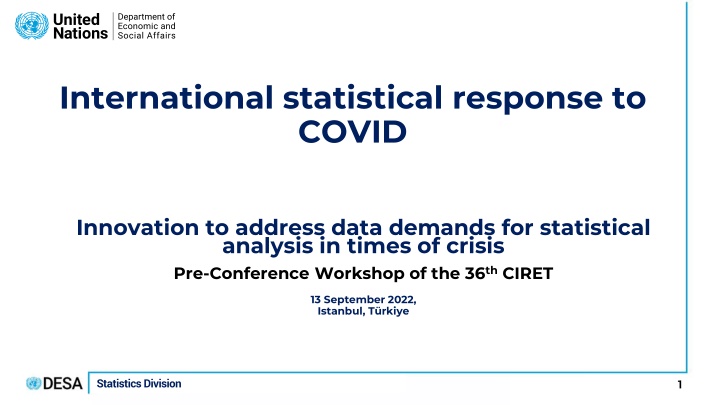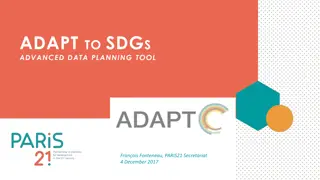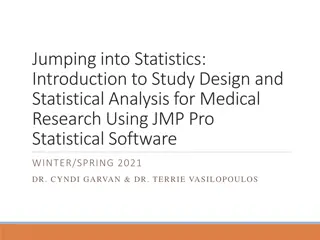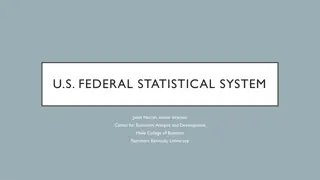Statistical Response to COVID-19 Innovation Addressing Data Demands
International statistical response to COVID-19 focused on addressing data demands for statistical analysis during times of crisis. The Global COVID-19 survey of NSOs highlighted the challenges and thematic areas covered. Decision 52/102 by the Statistical Commission emphasized the importance of monitoring the impact of the pandemic on national statistical offices. The Cape Town Global Action Plan aimed to support official statistics in implementing and financing the current CTGAP. It also sought to identify new statistical priorities resulting from the pandemic and accelerate actions towards the SDGs.
Download Presentation

Please find below an Image/Link to download the presentation.
The content on the website is provided AS IS for your information and personal use only. It may not be sold, licensed, or shared on other websites without obtaining consent from the author.If you encounter any issues during the download, it is possible that the publisher has removed the file from their server.
You are allowed to download the files provided on this website for personal or commercial use, subject to the condition that they are used lawfully. All files are the property of their respective owners.
The content on the website is provided AS IS for your information and personal use only. It may not be sold, licensed, or shared on other websites without obtaining consent from the author.
E N D
Presentation Transcript
International statistical response to COVID Innovation to address data demands for statistical analysis in times of crisis Pre-Conference Workshop of the 36th CIRET 13 September 2022, Istanbul, T rkiye Statistics Division 1
The Global COVID-19 survey of NSOs Motivation: Covid-19 upended statistical operations. Double burden: disruptions/more constrained environment AND increased data demand. Objective: Provide information to the global statistical community, donors, development partners and the general public to effectively mobilize technical and financial support to statistical activities that most urgently need it. Conveners: United Nations Statistics Division and World Bank s Development Data Group, in coordination with UN Regional Commissions Four waves: 5 17 May 2020 (response rate: 122/218) 7 25 Jul 2020 (response rate: 112/195) 23 Sep 15 Oct 2020 (response rate: 125/195) 16 April 10 May 2021 (response rate: 118/195) Statistics Division
The Global COVID-19 survey of NSOs Thematic areas covered: Telecommuting and office-based work Impact on face-to-face data collection Continuity of major statistical programs (surveys, censuses) Impact on short-term statistics, data dissemination (publications) and international reporting Response to new information demands Challenges in collecting data on population groups of special interest Use of new data sources ICT readiness and resource constraints Emergency plans, field protocols Coordination, partnerships, data stewardship Statistics Division
Decision 52/102 (j) by the Statistical Commission The international statistical community welcomed the monitoring of the impact of the coronavirus disease (COVID-19) crisis on national statistical offices Acknowledged that it allows for sharing of experiences and can provide direction in the allocation of much-needed support Statistics Division 4
Cape Town Global Action Plan Builds on past rounds of Global COVID-19 survey of NSOs Objective: Inform the action to better support official statistics in the implementation and financing of the current CTGAP, and to develop future global action plans in view of new statistical priorities resulting from the COVID-19 pandemic. Monitor progress on strategic areas of the Cape Town Global Action Plan (2017) Cape Town Global Action Plan for Sustainable Development Data SDG Indicators (un.org) Explore financing needs of NSOs to inform the Clearinghouse for Financing Development Data and the World Bank s Global Data Facility Identify new statistical priorities as a result of the impact of the COVID-19 pandemic Accelerate actions towards the SDGs Statistics Division 5
Topics covered by the CTGAP survey: Coordination and strategic leadership on data for sustainable development Innovation and modernisation of national statistical systems Strengthening of basic statistical activities and programmes Dissemination and use of sustainable development data Multi-stakeholder partnerships for sustainable development data Financing needs Statistics Division 6
Some key results Statistics Division 7
Many NSOs in L/LMIC had to postpone their Population and Housing Census Statistics Division 8
and while many NSOs had reopened after widespread initial closures the trend started to reverse in 2021. Statistics Division 9
After an almost universal suspension of face-to-face data collection, some in person data collection is resuming. 6 Statistics Division 10
Remote work has been the solution in most cases Is staff instructed to work from home? Statistics Division 11
But the majority of NSOs are facing shortages in financial resources and IT infrastructure. This is especially the case in low and lower middle- income countries There is also unmet demand for technical assistance and capacity development Does your organization currently face a shortage in the following resources to respond to demand for statistical outputs? Low and lower middle-income countries Financial resources 8 43 49 Major IT infrastructure (local and cloud server infrastructure, internet connectivity) 8 62 30 Office space and facilities 32 41 24 3 Technical assistance / capacity development 14 73 14 N=35 obs. Percent All countries Financial resources 22 48 29 1 Major IT infrastructure (local and cloud server infrastructure, internet connectivity) 34 46 19 Office space and facilities 48 34 15 2 Technical assistance / capacity development 34 58 7 1 N=99 obs. Percent No shortage Moderate Severe Don't know Source: Preliminary results from the Cape Town Global Action Plan Implementation Review. Global survey of National Statistical Offices. Implemented by Paris21, UNSD and the World Bank, 2021. Statistics Division 12
Information and Communication Technology (ICT) readiness during the COVID-19 pandemic The most common challenges in ICT during COVID-19 pandemic are on connectivity issues and remote data processing capabilities Staff have adequate internet access at home to work remotely 6 22 28 31 14 The office has in place provisions for staff to securely access data remotely 8 25 19 36 8 The office has access to adequate cloud computing services for remote data storage and data exchange 3 31 19 36 8 The office has adequate ICT facilities for remote training of staff and enumerators 6 28 28 25 11 All staff working from home have adequate computers to perform their work 3 39 25 31 The office has adequate ICT facilities and software for remote data collection 6 36 19 25 11 Staff are provided with adequate platforms to perform collaborative work remotely (meeting platforms, file sharing arrangements) 11 33 22 25 6 The office has adequate facilities to conduct video conferences 11 44 14 22 8 0 20 40 60 80 100 Percent N=98 obs. Strongly agree Agree Neutral Disagree Strongly disagree Not applicable Don't know Source: Preliminary results from the Cape Town Global Action Plan Implementation Review. Global survey of National Statistical Offices. Implemented by Paris21, UNSD and the World Bank, 2021. Statistics Division 13
Information and Communication Technology (ICT) readiness during the COVID-19 pandemic. There is a digital divide in ICT- readiness of NSOs across income levels Staff have adequate internet access at home to work remotely 4 100 6 14 15 17 80 31 30 Percent 60 34 28 40 41 43 20 22 Inadequate internet access at home and ICT facilities for remote training of staff and enumerators are more pronounced in low and lower- middle income countries 11 6 0 N=98 obs. High income Upper-middle income Low and lower-middle income The office has adequate ICT facilities for remote training of staff and enumerators 3 3 100 3 11 11 6 7 9 80 15 25 34 Percent 60 28 52 40 46 20 28 15 6 0 High income Upper-middle income Low and lower-middle income N=98 obs. Strongly agree Agree Neutral Disagree Strongly disagree Don't know Source: Preliminary results from the Cape Town Global Action Plan Implementation Review. Global survey of National Statistical Offices. Implemented by Paris21, UNSD and the World Bank, 2021. Statistics Division 14
Severity of delays in budget disbursements affecting ability to implement NSO workplans in IDA countries Majority of NSOs in IDA countries reported moderate or severe delays in budget disbursement in 2021 Dependent on external support Yes, severe delays 6 Yes, moderate delays 13 No delay 8 Not applicable 2 0 5 10 15 Number of NSOs N=29, all respondents are IDA countries Source: Preliminary results from the Cape Town Global Action Plan Implementation Review. Global survey of National Statistical Offices. Implemented by Paris21, UNSD and the World Bank, 2021. Statistics Division 15
To modernize the National Statistical System, what are the priority areas where the NSO plans to invest is capacity development over the next three years? Overall, the use of administrative use of administrative data and statistical registers data and statistical registers is the area of capacity development most frequently identified as a priority for investments, followed by coordination among NSS coordination among NSS members and data exchange and members and data exchange and dissemination. dissemination. However, coordination of NSS is coordination of NSS is the most common priority the most common priority among low and lower among low and lower- -middle income countries. income countries. Percent 0 20 40 60 80 100 Administrative data and statistical registers 89 Coordination among NSS members 84 Data exchange and dissemination 83 Data quality assurance 79 Data processing and analysis 77 Integration of geospatialstatistical systems 70 Implementation of statistical standards in specific domains 65 Disaggregation of data on gender and population groups 60 Protection of data privacy and confidentiality 59 Statistical legislation / regulatory framework 58 middle New concepts & methods for measuring sustainable dev. 54 Public-public / public-private partnerships 54 Don t know 2 N=98 obs. Source: Preliminary results from the Cape Town Global Action Plan Implementation Review. Global survey of National Statistical Offices. Implemented by Paris21, UNSD and the World Bank, 2021. Statistics Division 16
Priority areas of training More than two thirds of NSOs in low and lower middle-income countries indicated data management, processing and analysis as a high- priority area of training. This was followed by the need for training on management of the statistical organization and on leadership skills and coordination. All NSOs in low and lower middle- income countries indicate that training in dissemination and communication of statistical outputs is a moderate or high priority. Priority for the following areas of training for your organization Low and lower middle-income countries Data management, processing and analysis 69 28 3 Management of the statistical organisation 62 35 3 Leadership and coordination 59 35 5 Dissemination and communication of statistical outputs 58 42 Identification of statistical needs and solutions 58 31 8 Validation of data inputs 50 44 6 Design and development of statistical products and services 49 41 8 Data collection 44 36 17 0 20 40 60 80 100 Percent N=35 obs. High priority Moderate priority Not a priority Don't know Source: Preliminary results from the Cape Town Global Action Plan Implementation Review. Global survey of National Statistical Offices. Implemented by Paris21, UNSD and the World Bank, 2021. Statistics Division 17
Takeaway messages Large, still ongoing impacts on statistical operations Double burden: Increased demands amid disruptions Risk of exacerbating global data inequities Response induced accelerated innovation with lasting effects - but more support needed Emerging needs: Resources, ICT infrastructure, technical assistance, coordination Preparing for future crises: Need to invest in enhancing resiliency of statistical systems and strengthen contingency plans Statistics Division 18
Thank you! Statistics Division























